Protein-coding gene in the species Homo sapiens
| NCF4 |
|---|
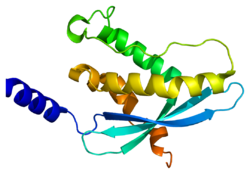 |
| Available structures |
|---|
| PDB | Ortholog search: PDBe RCSB |
|---|
| List of PDB id codes |
|---|
1H6H, 1OEY, 1W6X, 1W70, 1Z9Q, 2DYB |
|
|
| Identifiers |
|---|
| Aliases | NCF4, NCF, P40PHOX, SH3PXD4, Neutrophil cytosolic factor 4, CGD3 |
|---|
| External IDs | OMIM: 601488; MGI: 109186; HomoloGene: 525; GeneCards: NCF4; OMA:NCF4 - orthologs |
|---|
| Gene location (Human) |
|---|
 | | Chr. | Chromosome 22 (human)[1] |
|---|
| | Band | 22q12.3 | Start | 36,860,988 bp[1] |
|---|
| End | 36,878,017 bp[1] |
|---|
|
| Gene location (Mouse) |
|---|
 | | Chr. | Chromosome 15 (mouse)[2] |
|---|
| | Band | 15 E1|15 37.1 cM | Start | 78,129,001 bp[2] |
|---|
| End | 78,146,780 bp[2] |
|---|
|
| RNA expression pattern |
|---|
| Bgee | | Human | Mouse (ortholog) |
|---|
| Top expressed in | - blood
- spleen
- granulocyte
- bone marrow
- monocyte
- bone marrow cells
- appendix
- lymph node
- synovial membrane
- placenta
|
| | Top expressed in | - granulocyte
- blood
- tibiofemoral joint
- spleen
- mesenteric lymph nodes
- bone marrow
- fetal liver hematopoietic progenitor cell
- stroma of bone marrow
- embryo
- internal carotid artery
|
| | More reference expression data |
|
|---|
| BioGPS | 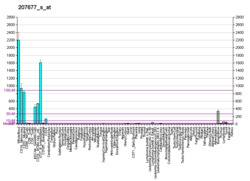
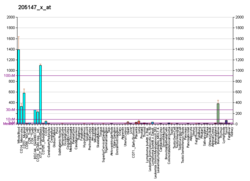 | | More reference expression data |
|
|---|
|
| Gene ontology |
|---|
| Molecular function | - protein dimerization activity
- phosphatidylinositol-3-phosphate binding
- protein binding
- phosphatidylinositol binding
- lipid binding
- superoxide-generating NADPH oxidase activator activity
| | Cellular component | - cytoplasm
- cytosol
- endosome
- membrane
- phagolysosome
- endosome membrane
- trans-Golgi network
- NADPH oxidase complex
| | Biological process | - vascular endothelial growth factor receptor signaling pathway
- immune response
- positive regulation of catalytic activity
- vesicle-mediated transport
- phagocytosis
- respiratory burst
- superoxide metabolic process
- antigen processing and presentation of exogenous peptide antigen via MHC class I, TAP-dependent
- cellular response to oxidative stress
- cell redox homeostasis
| | Sources:Amigo / QuickGO |
|
| Orthologs |
|---|
| Species | Human | Mouse |
|---|
| Entrez | | |
|---|
| Ensembl | |
|---|
ENSG00000275990
ENSG00000100365 |
| |
|---|
| UniProt | | |
|---|
| RefSeq (mRNA) | | |
|---|
| RefSeq (protein) | | |
|---|
| Location (UCSC) | Chr 22: 36.86 – 36.88 Mb | Chr 15: 78.13 – 78.15 Mb |
|---|
| PubMed search | [3] | [4] |
|---|
|
| Wikidata |
| View/Edit Human | View/Edit Mouse |
|
Neutrophil cytosol factor 4 is a protein that in humans is encoded by the NCF4 gene.[5][6]
Function
The protein encoded by this gene is a cytosolic regulatory component of the superoxide-producing phagocyte NADPH-oxidase, a multicomponent enzyme system important for host defense. This protein is preferentially expressed in cells of myeloid lineage. It interacts primarily with neutrophil cytosolic factor 2 (NCF2/p67-phox) to form a complex with neutrophil cytosolic factor 1 (NCF1/p47-phox), which further interacts with the small G protein RAC1 and translocates to the membrane upon cell stimulation. This complex then activates flavocytochrome b, the membrane-integrated catalytic core of the enzyme system. The PX domain of this protein can bind phospholipid products of the PI(3) kinase, which suggests its role in PI(3) kinase-mediated signaling events. The phosphorylation of this protein was found to negatively regulate the enzyme activity. Alternatively spliced transcript variants encoding distinct isoforms have been observed.
Clinical significance
GWAS studies showed that Crohn's disease patient with certain SNPs in NCF4 are more susceptible to get Crohn's disease.[7] Crohn's patient with rs4821544 variants showed a decreased reactive oxygen species after stimulation with GM-CSF which is a proinflammtory cytokine.[8]
Interactions
Neutrophil cytosolic factor 4 has been shown to interact with Ku70,[9] Neutrophil cytosolic factor 1[10][11][12] and Moesin.[13]
References
- ^ a b c ENSG00000100365 GRCh38: Ensembl release 89: ENSG00000275990, ENSG00000100365 – Ensembl, May 2017
- ^ a b c GRCm38: Ensembl release 89: ENSMUSG00000071715 – Ensembl, May 2017
- ^ "Human PubMed Reference:". National Center for Biotechnology Information, U.S. National Library of Medicine.
- ^ "Mouse PubMed Reference:". National Center for Biotechnology Information, U.S. National Library of Medicine.
- ^ Zhan S, Vazquez N, Zhan S, Wientjes FB, Budarf ML, Schrock E, Ried T, Green ED, Chanock SJ (Nov 1996). "Genomic structure, chromosomal localization, start of transcription, and tissue expression of the human p40-phox, a new component of the nicotinamide adenine dinucleotide phosphate-oxidase complex". Blood. 88 (7): 2714–21. doi:10.1182/blood.V88.7.2714.bloodjournal8872714. PMID 8839867.
- ^ "Entrez Gene: NCF4 neutrophil cytosolic factor 4, 40kDa".
- ^ Muise AM, Xu W, Guo CH, Walters TD, Wolters VM, Fattouh R, Lam GY, Hu P, Murchie R, Sherlock M, Gana JC, Russell RK, Glogauer M, Duerr RH, Cho JH, Lees CW, Satsangi J, Wilson DC, Paterson AD, Griffiths AM, Silverberg MS, Brumell JH (2012). "NADPH oxidase complex and IBD candidate gene studies: identification of a rare variant in NCF2 that results in reduced binding to RAC2". Gut. 61 (7): 1028–35. doi:10.1136/gutjnl-2011-300078. PMC 3806486. PMID 21900546.
- ^ Somasundaram R, Deuring JJ, van der Woude CJ, Peppelenbosch MP, Fuhler GM (2012). "Linking risk conferring mutations in NCF4 to functional consequences in Crohn's disease". Gut. 61 (7): 1097, author reply 1097–8. doi:10.1136/gutjnl-2011-301344. PMID 22027479. S2CID 5315006.
- ^ Grandvaux N, Grizot S, Vignais PV, Dagher MC (Feb 1999). "The Ku70 autoantigen interacts with p40phox in B lymphocytes". J. Cell Sci. 112 ( Pt 4) (4): 503–13. doi:10.1242/jcs.112.4.503. PMID 9914162.
- ^ Lapouge K, Smith SJ, Groemping Y, Rittinger K (Mar 2002). "Architecture of the p40-p47-p67phox complex in the resting state of the NADPH oxidase. A central role for p67phox". J. Biol. Chem. 277 (12): 10121–8. doi:10.1074/jbc.M112065200. PMID 11796733.
- ^ Grizot S, Grandvaux N, Fieschi F, Fauré J, Massenet C, Andrieu JP, Fuchs A, Vignais PV, Timmins PA, Dagher MC, Pebay-Peyroula E (Mar 2001). "Small angle neutron scattering and gel filtration analyses of neutrophil NADPH oxidase cytosolic factors highlight the role of the C-terminal end of p47phox in the association with p40phox". Biochemistry. 40 (10): 3127–33. doi:10.1021/bi0028439. PMID 11258927.
- ^ Sathyamoorthy M, de Mendez I, Adams AG, Leto TL (Apr 1997). "p40(phox) down-regulates NADPH oxidase activity through interactions with its SH3 domain". J. Biol. Chem. 272 (14): 9141–6. doi:10.1074/jbc.272.14.9141. PMID 9083043.
- ^ Wientjes FB, Reeves EP, Soskic V, Furthmayr H, Segal AW (Nov 2001). "The NADPH oxidase components p47(phox) and p40(phox) bind to moesin through their PX domain". Biochem. Biophys. Res. Commun. 289 (2): 382–8. doi:10.1006/bbrc.2001.5982. PMID 11716484.
Further reading
- Matute JD, Arias AA, Dinauer MC, Patiño PJ (2006). "p40phox: the last NADPH oxidase subunit". Blood Cells Mol. Dis. 35 (2): 291–302. doi:10.1016/j.bcmd.2005.06.010. PMID 16102984.
- Jones JH (1977). "The essence of operating room nursing. Paramedical personnel". Australas Nurses J. 7 (1): 44–5, 63–4. PMID 243433.
- Leto TL, Adams AG, de Mendez I (1994). "Assembly of the phagocyte NADPH oxidase: binding of Src homology 3 domains to proline-rich targets". Proc. Natl. Acad. Sci. U.S.A. 91 (22): 10650–4. Bibcode:1994PNAS...9110650L. doi:10.1073/pnas.91.22.10650. PMC 45079. PMID 7938008.
- Maruyama K, Sugano S (1994). "Oligo-capping: a simple method to replace the cap structure of eukaryotic mRNAs with oligoribonucleotides". Gene. 138 (1–2): 171–4. doi:10.1016/0378-1119(94)90802-8. PMID 8125298.
- Tsunawaki S, Mizunari H, Nagata M, Tatsuzawa O, Kuratsuji T (1994). "A novel cytosolic component, p40phox, of respiratory burst oxidase associates with p67phox and is absent in patients with chronic granulomatous disease who lack p67phox". Biochem. Biophys. Res. Commun. 199 (3): 1378–87. doi:10.1006/bbrc.1994.1383. PMID 8147882.
- Wientjes FB, Hsuan JJ, Totty NF, Segal AW (1993). "p40phox, a third cytosolic component of the activation complex of the NADPH oxidase to contain src homology 3 domains". Biochem. J. 296 ( Pt 3) (3): 557–61. doi:10.1042/bj2960557. PMC 1137734. PMID 8280052.
- Dusi S, Donini M, Rossi F (1996). "Mechanisms of NADPH oxidase activation: translocation of p40phox, Rac1 and Rac2 from the cytosol to the membranes in human neutrophils lacking p47phox or p67phox". Biochem. J. 314 ( Pt 2) (2): 409–12. doi:10.1042/bj3140409. PMC 1217064. PMID 8670049.
- Someya A, Nagaoka I, Nunoi H, Yamashita T (1996). "Translocation of guinea pig p40-phox during activation of NADPH oxidase". Biochim. Biophys. Acta. 1277 (3): 217–25. doi:10.1016/s0005-2728(96)00099-0. PMID 8982388.
- Sathyamoorthy M, de Mendez I, Adams AG, Leto TL (1997). "p40(phox) down-regulates NADPH oxidase activity through interactions with its SH3 domain". J. Biol. Chem. 272 (14): 9141–6. doi:10.1074/jbc.272.14.9141. PMID 9083043.
- Grogan A, Reeves E, Keep N, Wientjes F, Totty NF, Burlingame AL, Hsuan JJ, Segal AW (1997). "Cytosolic phox proteins interact with and regulate the assembly of coronin in neutrophils". J. Cell Sci. 110 ( Pt 24) (24): 3071–81. doi:10.1242/jcs.110.24.3071. PMID 9365277.
- Fuchs A, Bouin AP, Rabilloud T, Vignais PV (1997). "The 40-kDa component of the phagocyte NADPH oxidase (p40phox) is phosphorylated during activation in differentiated HL60 cells". Eur. J. Biochem. 249 (2): 531–9. doi:10.1111/j.1432-1033.1997.00531.x. PMID 9370364.
- Suzuki Y, Yoshitomo-Nakagawa K, Maruyama K, Suyama A, Sugano S (1997). "Construction and characterization of a full length-enriched and a 5'-end-enriched cDNA library". Gene. 200 (1–2): 149–56. doi:10.1016/S0378-1119(97)00411-3. PMID 9373149.
- Bouin AP, Grandvaux N, Vignais PV, Fuchs A (1998). "p40(phox) is phosphorylated on threonine 154 and serine 315 during activation of the phagocyte NADPH oxidase. Implication of a protein kinase c-type kinase in the phosphorylation process". J. Biol. Chem. 273 (46): 30097–103. doi:10.1074/jbc.273.46.30097. PMID 9804763.
- Grandvaux N, Grizot S, Vignais PV, Dagher MC (1999). "The Ku70 autoantigen interacts with p40phox in B lymphocytes". J. Cell Sci. 112 ( Pt 4) (4): 503–13. doi:10.1242/jcs.112.4.503. PMID 9914162.
- Nishiyama A, Ohno T, Iwata S, Matsui M, Hirota K, Masutani H, Nakamura H, Yodoi J (1999). "Demonstration of the interaction of thioredoxin with p40phox, a phagocyte oxidase component, using a yeast two-hybrid system". Immunol. Lett. 68 (1): 155–9. doi:10.1016/S0165-2478(99)00045-0. PMID 10397171.
- Hasebe T, Someya A, Nagaoka I (1999). "Identification of a splice variant mRNA of p40phox, an NADPH oxidase component of phagocytes". FEBS Lett. 455 (3): 257–61. doi:10.1016/S0014-5793(99)00905-9. PMID 10437784. S2CID 23509959.
- Dunham I, Shimizu N, Roe BA, Chissoe S, Hunt AR, Collins JE, Bruskiewich R, Beare DM, Clamp M, Smink LJ, Ainscough R, Almeida JP, Babbage A, Bagguley C, Bailey J, Barlow K, Bates KN, Beasley O, Bird CP, Blakey S, Bridgeman AM, Buck D, Burgess J, Burrill WD, O'Brien KP (1999). "The DNA sequence of human chromosome 22". Nature. 402 (6761): 489–95. Bibcode:1999Natur.402..489D. doi:10.1038/990031. PMID 10591208.
- Vergnaud S, Paclet MH, El Benna J, Pocidalo MA, Morel F (2000). "Complementation of NADPH oxidase in p67-phox-deficient CGD patients p67-phox/p40-phox interaction". Eur. J. Biochem. 267 (4): 1059–67. doi:10.1046/j.1432-1327.2000.01097.x. PMID 10672014.
- Grizot S, Grandvaux N, Fieschi F, Fauré J, Massenet C, Andrieu JP, Fuchs A, Vignais PV, Timmins PA, Dagher MC, Pebay-Peyroula E (2001). "Small angle neutron scattering and gel filtration analyses of neutrophil NADPH oxidase cytosolic factors highlight the role of the C-terminal end of p47phox in the association with p40phox". Biochemistry. 40 (10): 3127–33. doi:10.1021/bi0028439. PMID 11258927.
PDB gallery
-
1h6h: STRUCTURE OF THE PX DOMAIN FROM P40PHOX BOUND TO PHOSPHATIDYLINOSITOL 3-PHOSPHATE -
1oey: HETERODIMER OF P40PHOX AND P67PHOX PB1 DOMAINS FROM HUMAN NADPH OXIDASE -
1w6x: SH3 DOMAIN OF P40PHOX, COMPONENT OF THE NADPH OXIDASE -
1w70: SH3 DOMAIN OF P40PHOX COMPLEXED WITH C-TERMINAL POLYPROLINE REGION OF P47PHOX -
1z9q: Solution structure of SH3 domain of p40phox -
2dyb: The crystal structure of human p40(phox) |
|
|---|
| 1.6.1: NAD/NADP | - NAD(P)+ transhydrogenase (Si-specific)
- NAD(P)+ transhydrogenase (Re/Si-specific)
|
|---|
| 1.6.2: Heme | |
|---|
| 1.6.3: Oxygen | |
|---|
| 1.6.5: Quinone or similar | |
|---|
| 1.6.6: Nitrogenous group | |
|---|
| 1.6.99: other | - NADH dehydrogenase (quinone)
|
|---|

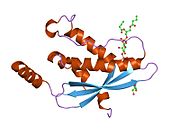 1h6h: STRUCTURE OF THE PX DOMAIN FROM P40PHOX BOUND TO PHOSPHATIDYLINOSITOL 3-PHOSPHATE
1h6h: STRUCTURE OF THE PX DOMAIN FROM P40PHOX BOUND TO PHOSPHATIDYLINOSITOL 3-PHOSPHATE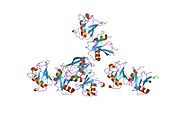 1oey: HETERODIMER OF P40PHOX AND P67PHOX PB1 DOMAINS FROM HUMAN NADPH OXIDASE
1oey: HETERODIMER OF P40PHOX AND P67PHOX PB1 DOMAINS FROM HUMAN NADPH OXIDASE 1w6x: SH3 DOMAIN OF P40PHOX, COMPONENT OF THE NADPH OXIDASE
1w6x: SH3 DOMAIN OF P40PHOX, COMPONENT OF THE NADPH OXIDASE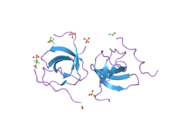 1w70: SH3 DOMAIN OF P40PHOX COMPLEXED WITH C-TERMINAL POLYPROLINE REGION OF P47PHOX
1w70: SH3 DOMAIN OF P40PHOX COMPLEXED WITH C-TERMINAL POLYPROLINE REGION OF P47PHOX 1z9q: Solution structure of SH3 domain of p40phox
1z9q: Solution structure of SH3 domain of p40phox 2dyb: The crystal structure of human p40(phox)
2dyb: The crystal structure of human p40(phox)























